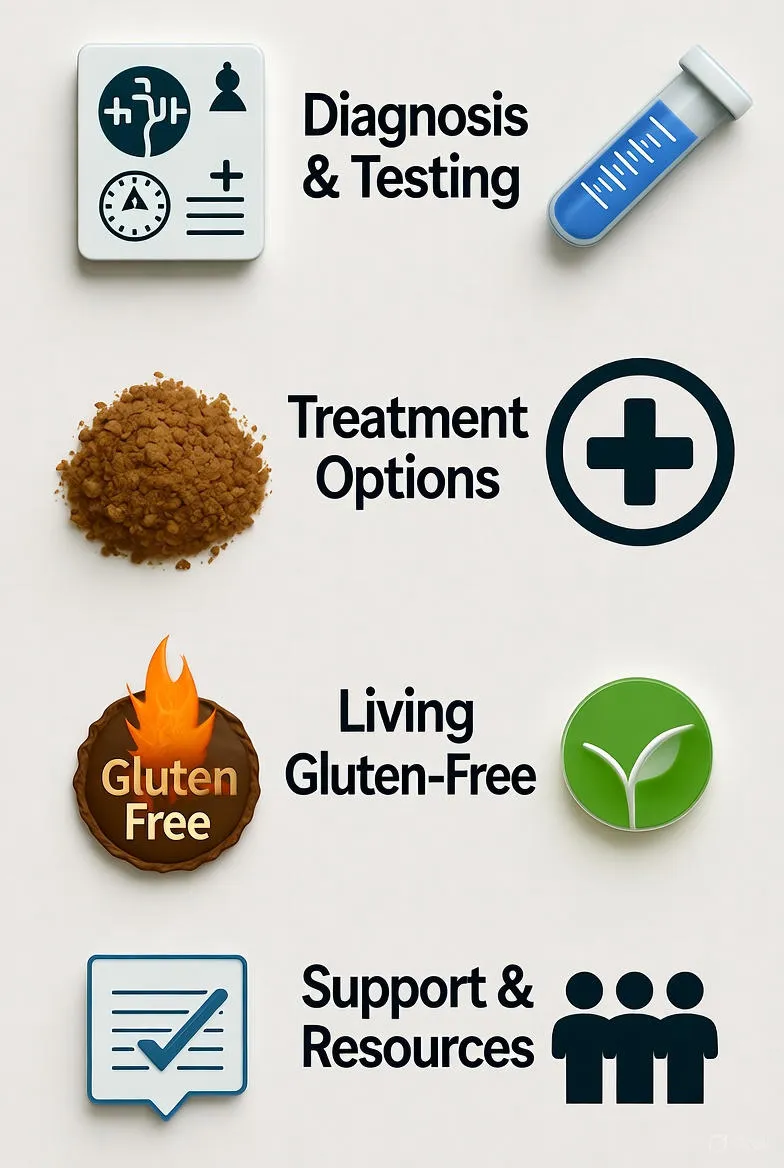Gluten Sensitivity vs. Celiac Disease: Key Differences and How to Tell Them Apart
Discover the key differences between gluten sensitivity and celiac disease, including symptoms, diagnosis, and treatment options. Learn how to identify which condition you might have and manage it effectively for better health.

Introduction
Navigating the world of gluten-related disorders can be confusing for many people. With terms like 'gluten sensitivity' and 'celiac disease' often used interchangeably in casual conversation, it's easy to mix them up. However, these two conditions, while sharing some similarities, have distinct causes, symptoms, and implications for long-term health. Understanding the differences between gluten sensitivity (also known as non-celiac gluten sensitivity) and celiac disease is crucial for anyone experiencing digestive discomfort after consuming gluten-containing foods. This article will delve into the definitions, symptoms, diagnostic processes, treatments, and key distinctions to help you gain clarity and make informed decisions about your health.
Gluten, a protein found in wheat, barley, and rye, has become a buzzword in health and wellness circles. For most people, it's harmless and even essential in everyday baking and cooking. But for a significant portion of the population, gluten can trigger a range of unpleasant reactions. Celiac disease affects about 1% of people worldwide and is an autoimmune disorder, whereas gluten sensitivity is more common but less understood, impacting an estimated 6% of the population. Let's break it down step by step.
What is Celiac Disease?
Celiac disease is a serious autoimmune condition where the ingestion of gluten leads to damage in the small intestine. When someone with celiac disease eats gluten, their immune system mistakenly attacks the lining of the small intestine, specifically the tiny, finger-like projections called villi. These villi are responsible for nutrient absorption, so their damage can lead to malnutrition and a host of other health issues.
The exact cause of celiac disease isn't fully known, but genetics play a major role. If you have a first-degree relative with celiac disease, your risk increases dramatically. Environmental factors, such as early introduction of gluten in infancy or certain infections, may also trigger the onset in genetically predisposed individuals. Unlike many autoimmune diseases, celiac disease is directly linked to a specific dietary trigger: gluten.
Symptoms of Celiac Disease
Symptoms of celiac disease can vary widely, making it tricky to diagnose. Some people experience classic gastrointestinal issues, while others have no digestive symptoms at all. Common signs include:
- Diarrhea or constipation: Chronic and alternating bowel habits.
- Abdominal pain and bloating: Often described as a persistent, uncomfortable swelling.
- Fatigue and weakness: Due to nutrient malabsorption, leading to anemia or vitamin deficiencies.
- Weight loss: Unintentional, as the body struggles to absorb calories and nutrients.
- Skin rashes: Such as dermatitis herpetiformis, an itchy, blistering rash.
- Neurological symptoms: Headaches, migraines, or peripheral neuropathy (tingling in extremities).
- Bone and joint pain: From calcium and vitamin D deficiencies.
In children, celiac disease might manifest as delayed growth, irritability, or enamel defects on teeth. Importantly, some individuals remain asymptomatic for years, only discovering the condition through routine blood work or family screening.
Diagnosis of Celiac Disease
Diagnosing celiac disease involves a multi-step process to ensure accuracy and avoid false positives. The first step is typically blood tests that check for specific antibodies, such as anti-tissue transglutaminase (tTG-IgA) and anti-endomysial antibodies (EMA). These tests are highly sensitive and specific but require the patient to be consuming gluten at the time of testing.
If blood tests are positive, the next step is an upper endoscopy with biopsy of the small intestine. During this procedure, a gastroenterologist removes small tissue samples from the duodenum to examine under a microscope for villous atrophy—the hallmark of celiac damage. Genetic testing for HLA-DQ2 or HLA-DQ8 genes can support the diagnosis but isn't definitive on its own, as many people carry these genes without developing the disease.
Treatment for Celiac Disease
The only effective treatment for celiac disease is a strict, lifelong gluten-free diet. This means eliminating all sources of gluten, including hidden ones in processed foods, medications, and even some cosmetics. Upon starting the diet, most people see symptom improvement within weeks, though intestinal healing can take months to years.
Nutritional support is often necessary initially, with supplements for deficiencies like iron, B vitamins, and calcium. Regular follow-ups with a dietitian and gastroenterologist are recommended to monitor healing and adherence. Cross-contamination is a major concern— even trace amounts of gluten can cause damage—so many with celiac invest in separate kitchen tools and careful label reading.
What is Gluten Sensitivity?
Non-celiac gluten sensitivity (NCGS), or simply gluten sensitivity, refers to a condition where individuals experience symptoms similar to those of celiac disease or wheat allergy after consuming gluten, but without the autoimmune intestinal damage or allergic response. It's a diagnosis of exclusion—meaning other conditions must be ruled out first.
The mechanism behind gluten sensitivity is still under research. It may involve innate immune responses in the gut, changes in gut permeability (leaky gut), or even reactions to other components in wheat like FODMAPs (fermentable oligosaccharides, disaccharides, monosaccharides, and polyols). Unlike celiac, there's no genetic marker or definitive test, which adds to the diagnostic challenge.
Symptoms of Gluten Sensitivity
Symptoms of gluten sensitivity often overlap with celiac disease but tend to appear more quickly—within hours of gluten consumption—and resolve faster upon elimination. They include:
- Gastrointestinal distress: Bloating, gas, diarrhea, or constipation.
- Extraintestinal symptoms: Brain fog, headaches, joint pain, or fatigue.
- Mood changes: Anxiety, depression, or irritability.
- Skin issues: Eczema or other rashes, though less severe than dermatitis herpetiformis.
One key difference is that symptoms in gluten sensitivity don't typically lead to nutrient deficiencies or long-term organ damage, making it less severe in that regard. However, chronic symptoms can significantly impact quality of life.
Diagnosis of Gluten Sensitivity
There's no single test for gluten sensitivity, so diagnosis relies on a structured elimination diet followed by a blinded challenge. First, rule out celiac disease and wheat allergy with the appropriate tests. Then, eliminate gluten completely for at least four to six weeks while tracking symptoms in a food diary.
If symptoms improve, reintroduce gluten in a controlled manner—perhaps through a placebo-controlled challenge under medical supervision—to confirm the link. This process helps differentiate it from other intolerances, like to FODMAPs or histamine. Some researchers are exploring biomarkers like increased zonulin levels (a marker of gut permeability), but these aren't standardized yet.
Treatment for Gluten Sensitivity
Like celiac disease, the primary treatment is a gluten-free diet, but it may not need to be as rigidly strict. Many with gluten sensitivity can tolerate small amounts of gluten occasionally without symptoms, though this varies. The goal is symptom management, so working with a dietitian to identify personal thresholds is helpful.
Probiotics, digestive enzymes, or anti-inflammatory diets may provide additional relief. Unlike celiac, there's potential for outgrowing sensitivity or seeing improvement with gut-healing protocols, though evidence is anecdotal for now.
Key Differences Between Gluten Sensitivity and Celiac Disease
To make the distinctions clearer, here's a side-by-side comparison:
| Aspect | Celiac Disease | Gluten Sensitivity |
|---|---|---|
| Nature | Autoimmune disorder with intestinal damage | Non-autoimmune, no intestinal damage |
| Prevalence | ~1% of population | ~6% of population |
| Diagnosis | Blood tests, biopsy, genetic markers | Elimination diet and challenge |
| Symptom Onset | Gradual, chronic | Rapid, within hours |
| Long-term Risks | Malnutrition, osteoporosis, increased cancer risk | Primarily quality-of-life impact |
| Treatment Strictness | Lifelong, zero tolerance | Flexible, symptom-based |
These differences highlight why self-diagnosing and jumping straight to gluten-free without testing can be risky—missing celiac disease means ongoing damage, while unnecessary restriction limits dietary variety.
Similarities Between the Two Conditions
Despite their differences, gluten sensitivity and celiac disease share several traits. Both are triggered by gluten ingestion and present with overlapping symptoms, particularly gastrointestinal ones. They both benefit from gluten avoidance as the cornerstone of management. Additionally, both can be influenced by gut microbiome health and may coexist with other conditions like IBS (irritable bowel syndrome) or thyroid disorders.
Family history can play a role in both, though more strongly in celiac. Awareness of these overlaps encourages comprehensive testing to ensure the right diagnosis.
Living with Gluten-Related Issues
Whether you have celiac disease or gluten sensitivity, adopting a gluten-free lifestyle requires education and adaptation. Start by learning to read labels—look for 'gluten-free' certification from organizations like the Celiac Sprue Association. Stock your pantry with naturally gluten-free staples: rice, quinoa, fresh fruits and vegetables, lean proteins, and dairy (if tolerated).
Gluten-free baking has come a long way, with almond flour, coconut flour, and xanthan gum as go-to substitutes. Dining out? Apps like Find Me Gluten Free can locate safe restaurants. Support groups, such as those from the Celiac Disease Foundation, offer community and recipes.
Managing mental health is equally important. The frustration of label-reading or social isolation at meals can lead to stress. Mindfulness practices or therapy tailored to chronic illness can help. Remember, a gluten-free diet isn't inherently healthier for everyone—focus on nutrient-dense foods to avoid common pitfalls like high sugar or processed alternatives.
Recent Research and Future Directions
Ongoing research is shedding new light on these conditions. For celiac disease, studies explore enzyme therapies that could break down gluten in the gut, potentially allowing safe consumption for some. Vaccine trials, like those for Nexvax2, aim to desensitize the immune system. For gluten sensitivity, investigations into wheat components beyond gluten—such as amylase-trypsin inhibitors—are promising, suggesting that not all 'gluten' reactions are truly to gluten.
Personalized medicine, including microbiome analysis, may one day tailor treatments. Until then, staying informed through reputable sources like the National Institutes of Health or Beyond Celiac is key.
Conclusion
Distinguishing between gluten sensitivity and celiac disease empowers you to seek the right care and avoid unnecessary restrictions or overlooked damage. If you suspect either, consult a healthcare professional for proper testing—don't rely on online quizzes or symptom checklists alone. With the right diagnosis and management, both conditions can be well-controlled, allowing for a vibrant, symptom-free life. Whether it's through a meticulous gluten-free regimen or targeted elimination, taking charge of your gut health is a step toward overall well-being.
In the end, while the gluten-free trend has its skeptics, for those truly affected, it's a lifeline. Listen to your body, advocate for thorough evaluation, and embrace the abundance of gluten-free options available today. Your health journey is unique—make it informed and intentional.


